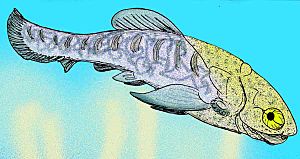Incisoscutum facts for kids
Quick facts for kids Incisoscutum |
|
|---|---|
 |
|
| Artist's reconstruction of I. ritchei | |
| Scientific classification | |
| Kingdom: | |
| Phylum: | |
| Class: | |
| Order: | |
| Family: |
Incisoscutidae
|
| Genus: |
Incisoscutum
Dennis & Miles, 1981
|
| Type species | |
| Incisoscutum ritchei Dennis & Miles, 1981
|
|
| Species | |
|
|
| Synonyms | |
|
|
Incisoscutum is a type of ancient armored fish called a placoderm. It belonged to a group known as arthrodires. These fish lived during the Late Devonian period, about 380 million years ago, in what is now Australia.
Scientists have found two species of Incisoscutum. One is I. ritchiei, named after Dr. Alex Ritchie, a fish fossil expert. The other is I. sarahae, named after Sarah Long, whose father, Dr. John A. Long, discovered it.
Incisoscutum is very important for understanding early vertebrates (animals with backbones). This is because scientists found amazing fossils of pregnant female Incisoscutum with their babies inside! They also found special structures on male fossils used for reproduction. This shows that these ancient fish could give birth to live young, just like many animals today.
Contents
Fossils of Incisoscutum
Scientists found incredible Incisoscutum fossils in the Gogo Formation in Western Australia. These fossils are special because they are three-dimensional and uncrushed. They even show some soft body parts, which is very rare for such old fossils. The Gogo Formation was once a warm, shallow-sea reef.
Palaeobiology: How Incisoscutum Lived
Reproduction: Live Birth
When Incisoscutum ritchiei was first studied, scientists found small bony plates inside two adult female fossils. At first, they thought these plates were the remains of the adult fish's last meal. This was because the plates were scattered and looked a bit digested.
However, after similar discoveries in other ancient fish called ptyctodonts, like Materpiscis attenboroughi, scientists looked at the Incisoscutum fossils again. They realized that the "last meals" were actually tiny embryos, about 5 centimeters long, inside the pregnant female fish!
The scattered plates and what looked like digestion were actually due to the fish's body opening up after it died. Also, tiny worm trails in the surrounding rock showed that the fish lay in the open for some time. This new understanding means that Incisoscutum was able to give birth to live young.
This discovery is super important! It's the oldest known example of live birth in any vertebrate. This means that internal fertilization (where the male fertilizes the eggs inside the female's body) and live birth evolved at least 380 million years ago.
Having live young meant that Incisoscutum invested more time and energy in fewer offspring. This is different from many fish today that lay huge numbers of eggs. This strategy suggests that the ancient reef environment was stable and safe. It probably had good hiding places for pregnant fish, allowing them to care for their developing young.
Pelvic Claspers: Male and Female Differences
Scientists also found differences between male and female Incisoscutum fossils. This is called sexual dimorphism, meaning males and females of the same species look different.
Male Incisoscutum had special bony structures called pelvic claspers. These were slender rods attached to a plate near their pelvic fins. These claspers were used for internal fertilization. The tip of the clasper had small bumps, possibly to help the male hold onto the female during mating.
Female Incisoscutum did not have these claspers. Instead, they had a broad pelvic plate that was shaped differently. This difference in pelvic structures clearly shows that males and females had distinct reproductive organs.
The discovery of claspers in Incisoscutum and other related fish suggests that these structures were common among many ancient armored fish. It's also possible that male and female Incisoscutum lived in different areas for most of their lives, only coming together to mate. This behavior is similar to some modern sharks.

